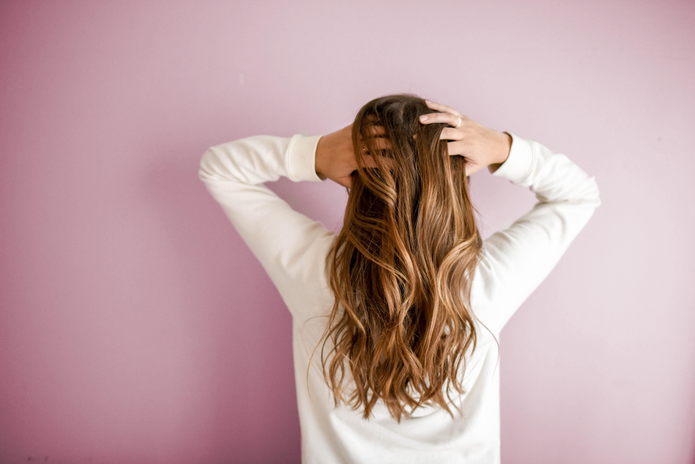The sudden boredom and confinement of the early days of quarantine offered many collective distractions. Some were more productive than others, like learning new culinary techniques through home-baked bread or whipped dalgona coffee. Others were more frivolous, but still provided a fun experience to connect or commune with others in times of isolation – Tiger King binge and conspiracy theories, anyone?
Few quarantine distractions were as dramatic – or as long-lasting – as the infamous “quarancut,” or quarantine haircut. With hair salons closed for the foreseeable future and no other outlets for my impulsive energy, I took a pair of kitchen scissors and hacked off my long, thick hair. Once skimming my waist, my new hair now barely grazed my chin.
While my new haircut had me feeling lighter in more ways than one, the aftermath after the initial uplifting gust of liberation was difficult to deal with. My choppy layers and coarse texture had me almost relieved at lockdown restrictions, grateful that no one had to see my Dora the Explorer-inspired look.
As the initial novelty of looking like Edna Mode waned, I resolved to not only grow out my hair but to work toward making it stronger and healthier than ever before.
My quest for my healthiest hair led me to identify considerations that were surprisingly personal and surprisingly scientific, including the porosity of my hair and the importance of a balance between protein and moisture.
Hair Porosity
Learning my hair porosity helped me to understand why certain hair conditioners, masks, and oils could sink into my hair and leave it softer and stronger while others would weigh it down and leave it feeling crunchy or greasy. My hair is low porosity, meaning that it is resistant to absorbing products and moisture. Heavier ingredients like shea butter simply “sat” on my coarse hair without ever absorbing, while lighter ingredients like grapeseed oil would sink right in and leave me with just the right amount of sheen and softness. To increase the absorption of products into my hair, I’d had to try other application techniques, including a “greenhouse” technique where I’d wrap my head in a plastic bag to create the moist heat that improves absorption.
There are a number of ways to test your hair porosity and many disputes about their accuracy. One test involves placing a strand of your hair in a glass of water. If the strand floats, your hair is low porosity. If it sinks, you have high porosity. Another method is as simple as running your fingers up your hair, from your ends toward your scalp. A smooth slip on your strands means your hair is low porosity, while a bumpy feeling indicates high porosity hair. Knowing your hair’s porosity level can inform how you treat it. While low porosity hair may require infrequent conditioning with lighter-weight treatments, high-porosity hair may welcome frequent and heavy products.

Protein vs. Moisture Balance
As one of the building blocks of your hair, protein is a great ingredient to have in your hair health arsenal. On an ingredients list, proteins can have names like “hydrolyzed keratin” or “silk protein.” Though protein is incredibly effective at strengthening your hair and helping it maintain its structure, too much of a good thing is possible. With too much protein, your hair can feel stiff, crunchy, and brittle – even snapping off at the ends! To avoid the dreaded “over-protein,” only leave on protein masks as long as directed and use products containing protein infrequently. People with low-porosity hair are especially susceptible to “over-protein” – if your hair is higher porosity, protein may feature more regularly in your haircare routine.
Moisture is also important. Finding moisturizers in the ingredients list of your hair products should be a much easier task than finding protein: ingredients like fatty alcohols, oils, and butters can all keep your hair feeling soft, smooth, and moisturized. Of course, too much of a good thing holds true for moisture too! If your damaged hair feels limp or even gummy when wet, chances are, it’s too moisturized (or you wet it too often, leading to a hydral fatigue that impacts its structure) and you’d probably benefit from a protein treatment. With protein and moisture, you’re aspiring towards a healthy balance between the two!
Rosemary Oil
Scalp massages with different oils have been a strategy for achieving healthy hair in different cultures for centuries. While different cultures swear by different blends of oils, rosemary essential oil is one of the most scientifically proven ingredients to include in your blend. Clinical trials have found rosemary oil to increase hair count as much as minoxidil, a hair growth medication you might recognize as Rogaine. In addition to stimulating hair growth, rosemary oil has the benefit of a relaxing, spa-like fragrance – like a mini aromatherapy treat.
As essential oils can be potent to the point that they irritate your scalp and skin, it’s important to mix rosemary oil with carrier oils. My personal favourite is grapeseed oil as it is lightweight and rinses clean with minimal effort, but people with drier or higher-porosity hair may benefit from slightly heavier oils, including argan, jojoba, or sweet almond. Feel free to customize your personal oil blend!
Silk Scrunchies and Silk Pillowcases
Silk pillowcases (or silk bonnets and headwraps) prevent moisture loss and reduce friction on your hair as you sleep, minimizing any damaging roughness as well as the appearance of tangles. Though it can be easy to confuse silk or satin, especially on online stores that often use the two interchangeably, there is a distinction between the two materials. Satin is more inexpensive, but the term is less regulated – while silk is a fiber, satin is a “weave,” meaning it can be composed of any one of a variety of materials, from non-breathable synthetic polyester to a more luxurious silk. While satin can be more inexpensive and readily available, silk is the gold standard material for breathable pillowcases that protect your hair.
The way you style your hair can also protect it. While styles vary in complexity, I find a low, loose bun tied with a scrunchie easy, effortless, and adequate to protect my hair while I sleep. I like 100% pure silk scrunchies because they don’t “tug” on my hair and their smooth, luxe fabric avoids friction. I’m also a big fan of shopping local and “buying what you believe in” so I get my scrunchies from ScrunchieeSisters on Etsy. The scrunchies are of amazing quality: durable, luxurious, and handmade from buttery soft 100% silk in the most beautiful colours and prints you can imagine. Also, as ScrunchieeSisters is a BIPOC-owned small business run by students from Queen’s, I’m happy knowing that I get to support my community while also nurturing my best hair health.
Microfiber Hair Towels
Your hair is most vulnerable to breakage when it’s wet so investing in a quality hair-drying towel is a great way to be proactive in preparing your hair. Microfiber hair towels are more absorbent and less rough than conventional towels. Bonus: they’re so soft and fluffy, like a cloud for your head!
Exploring the art and science of hair care has been a fun and fruitful adventure for my hair health. Wishing you all the joy of healthy hair and self-care!







